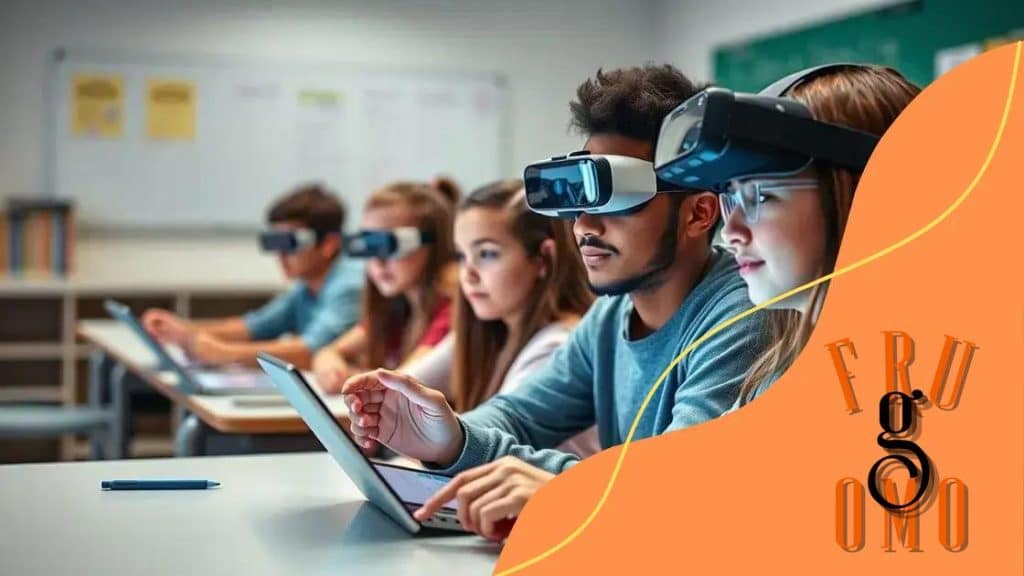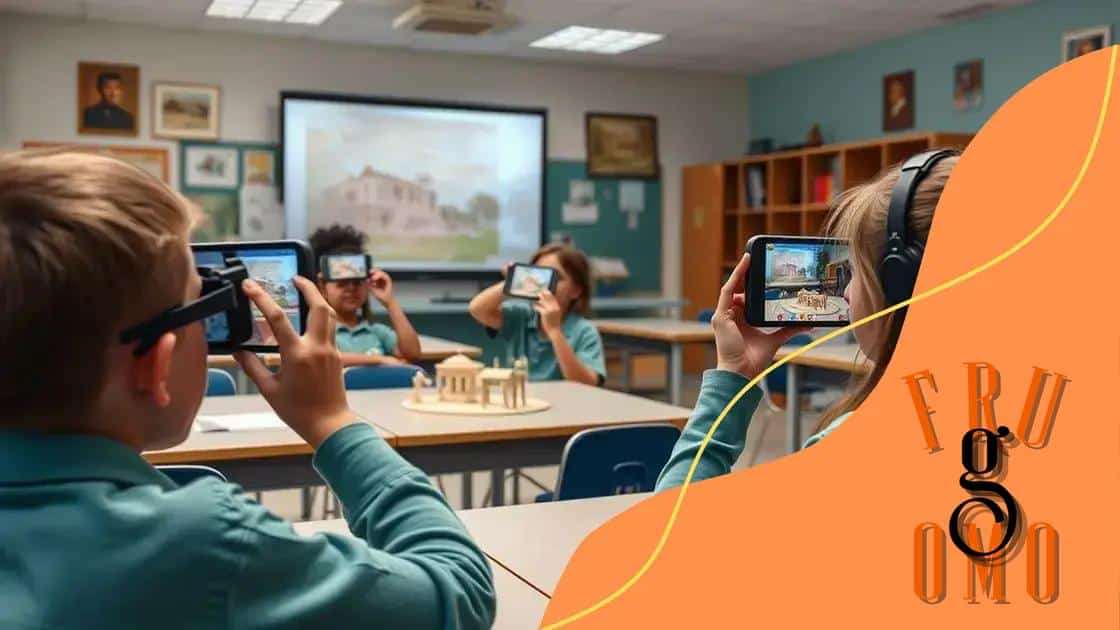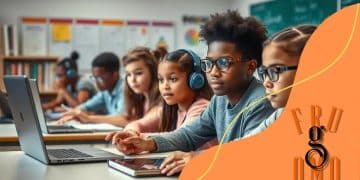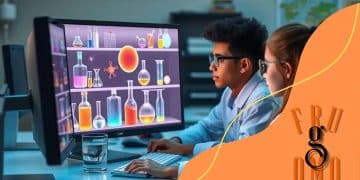How AR is being used for hands-on learning experiences

Augmented reality (AR) is transforming hands-on learning experiences in education by providing immersive, interactive environments that engage students and enhance understanding across various subjects.
How AR is being used for hands-on learning experiences is changing the way we approach education. Have you ever imagined learning anatomy by virtually dissecting a frog? AR offers these immersive experiences that bring lessons to life.
Understanding augmented reality in education
Understanding augmented reality in education is key to appreciating its transformative impact. By blending digital elements with the physical world, AR creates immersive experiences that enhance learning.
In classrooms today, teachers use AR to engage students in ways traditional methods cannot. For instance, when students study the solar system, they can see planets zooming around them rather than just looking at pictures in a textbook.
Key Features of Augmented Reality
Augmented reality offers several significant features that are beneficial in educational settings:
- Interactivity: Students can interact with 3D models, making lessons more engaging.
- Real-time information: Information can be presented instantly, helping students learn faster.
- Visual learning: Complex concepts are simplified through visualization, aiding comprehension.
These features demonstrate why AR is attractive to educators. As technology advances, more opportunities arise to enrich the curriculum. Lessons come to life, providing memorable experiences that students are likely to retain.
Applications in Education
Augmented reality can be used in various subjects such as science, history, and art. For example, in science classes, students can explore anatomical structures through interactive models. In history lessons, they might walk through ancient ruins recreated on their screens. Such applications bring contexts to life, fostering a deeper understanding of the material.
The impact of augmented reality in education doesn’t stop at engagement. It promotes collaboration among students. Group projects become more fun when students can share experiences through AR. This technology not only encourages teamwork but also develops essential skills like problem-solving and critical thinking.
As we see the potential of AR grow, educational institutions are beginning to invest in this technology. More schools are collaborating with tech companies to enhance their offerings. It’s clear that understanding augmented reality is essential for educators looking to innovate and improve learning outcomes.
Benefits of AR for hands-on learning
The benefits of AR for hands-on learning are vast and impactful. This technology enables students to interact with their lessons in an engaging way, making learning more effective and enjoyable.
One major advantage is the ability to visualize complex concepts. For example, when studying biology, students can explore the human body in 3D. This immersive experience helps them understand anatomy far better than traditional textbooks can.
Enhanced Engagement
With AR, students are more engaged and motivated. They can participate in activities that captivate their interest. This interactive learning format often leads to higher retention rates. When students are actively involved, they are more likely to remember what they learn.
- Improved participation: Students who may struggle in traditional settings often thrive with AR.
- Curiosity sparking: AR can ignite a love for learning by making education fun.
- Personalized learning: Each student can explore at their own pace, adjusting the experience to their needs.
Another significant benefit is the way AR promotes collaboration among students. Group projects using AR encourage teamwork as they work together to solve challenges. This collaboration helps build communication skills that are essential for future success.
Access to Resources
Augmented reality also provides access to resources that might not be available locally. Students can take virtual field trips to museums or historical sites, enhancing their knowledge beyond the classroom. These experiences can broaden their understanding of the world.
Moreover, AR can integrate seamlessly with various subjects. Whether it’s art, science, or mathematics, it can bring lessons to life. This versatile application means that teachers can use AR across the curriculum, enriching all aspects of education.
As schools continue to adopt this innovative technology, the benefits of AR are becoming increasingly clear. It helps create a more dynamic learning environment that caters to the diverse needs of students, making education more accessible and enjoyable for everyone.
Real-world applications of AR in classrooms

Real-world applications of AR in classrooms showcase how this technology can enhance learning experiences. Educators are using augmented reality to bring lessons to life, making complex subjects more approachable.
For example, in a history class, students can use AR to explore ancient cities right from their classroom desks. This immersive visual experience allows them to engage with history in a way that textbooks cannot provide.
Science Education
In science classes, AR applications allow students to observe and interact with 3D models of molecules, planets, or even ecosystems. This hands-on approach helps them grasp difficult concepts easily. Instead of just reading about the human body, students can see it fully formed and interact with it.
- Interactive dissections: Students can perform virtual dissections without the ethical concerns of using real specimens.
- Environmental simulations: Learners can experience ecological systems or climate changes in real-time.
- Astronomy experiences: Students can explore the solar system, viewing planets, or star formations up close.
Moreover, language learning is transformed with AR as well. Students can practice vocabulary by pointing their devices at real-world objects, receiving translations and pronunciations instantly. Such applications make learning a new language interactive and relatable.
Art and Creativity
AR isn’t just for science and history; it also empowers creativity. In art classes, students can create 3D models or paintings that come alive with AR. They can use their devices as tools to view their projects from different angles and improve their work with instant feedback.
Furthermore, AR encourages collaborative projects among students. They can work in groups to create shared AR experiences, developing teamwork and communication skills. This type of engagement isn’t just fun; it promotes deeper learning and retention.
As more educators recognize the potential of AR, we are likely to see even more innovative uses in the future. The possibilities are endless, and the classrooms of tomorrow will offer experiences that today’s students can only dream of.
Challenges educators face with AR
Challenges educators face with AR are critical to understand for effective implementation in the classroom. While augmented reality offers many benefits, hurdles remain that can affect its success.
One significant challenge is the need for reliable technology. Many schools may not have the necessary devices or infrastructure to support AR applications. This can lead to frustration for both teachers and students when they cannot effectively use the technology.
Training and Support
Another issue is the level of training required for teachers. Most educators are not experts in technology, and learning how to implement AR can be daunting. Ongoing training and support are crucial for teachers to feel comfortable using AR in their lessons.
- Understanding the software: Many AR tools can be complex, requiring time to learn.
- Resource allocation: Schools need to find funding for devices and software.
- Curriculum integration: Adjusting existing lesson plans to include AR can be challenging without proper guidance.
Additionally, some educators are concerned about the screen time that AR may add to the school day. While technology can be beneficial, too much use may lead to distractions or lessen face-to-face interactions among students. Balancing screen time and traditional learning methods is essential.
Accessibility Issues
Furthermore, accessibility can be a challenge. Not all students may have the same level of comfort or familiarity with technology. Some students might struggle with AR applications, which could lead to feelings of exclusion in a classroom setting.
Lastly, there is the issue of content quality. Not all AR apps offer high-quality, educational experiences. Educators must sift through many options to find tools that genuinely enhance learning. This process can be time-consuming and can lead to inconsistency in teaching. AR has the potential to transform education, but educators must navigate these challenges to make the most of it.
The future of AR in educational settings
The future of AR in educational settings looks very promising. As technology advances, augmented reality is expected to become more integrated into everyday learning experiences. This evolution can transform how students engage with their studies.
One key aspect is the development of more interactive and immersive content. As AR technology improves, we will likely see richer and more detailed simulations, allowing students to explore complex topics in depth. Imagine a history lesson where students can walk through a virtual ancient city or experience significant historical events firsthand.
Personalized Learning Experiences
Additionally, augmented reality has the potential to offer personalized learning experiences. Each student learns differently, and AR can adapt to those needs. For example, AR programs can adjust difficulty levels based on student performance, ensuring that everyone is challenged appropriately.
- Tailored feedback: AR can provide instant feedback, helping students learn from their mistakes right away.
- Diverse learning styles: Whether visual, auditory, or kinesthetic, AR can cater to multiple learning preferences.
- Engagement: Personalized content can increase student motivation, making them excited to learn.
Moreover, collaboration will play a vital role in the future of AR. As classrooms become more connected, students can work together across different locations using AR. This feature will foster teamwork and allow learners to share unique insights and experiences.
Integration into Curriculum
Future developments in teacher training will also be essential. Preparing educators to incorporate AR into their lessons will be crucial for maximizing its benefits. Workshops and professional development programs focused on AR can help teachers feel confident in using this technology effectively.
Moreover, we can expect partnerships between schools and tech companies to grow. This collaboration will lead to more accessible and cutting-edge AR tools designed specifically for education. As these resources become more widespread, the integration of AR into the curriculum will likely be seamless.
As we look ahead, the potential of augmented reality in education remains vast. With the right tools and training, the classroom of the future may look very different, making learning experiences more engaging, interactive, and personalized than ever before.
augmented reality in education is set to transform learning experiences. As technology advances, educators can harness its potential to make lessons more engaging, interactive, and personalized. However, challenges remain, such as training and access to resources. By addressing these issues, we can create classrooms that are vibrant and conducive to learning, preparing students for the future. The future of AR in education holds much promise, and it’s essential for schools to embrace this change for a better educational experience.
FAQ – Frequently Asked Questions about Augmented Reality in Education
What are the main benefits of using AR in classrooms?
The main benefits include increased engagement, enhanced interactivity, and improved retention of information as students interact with learning materials in new ways.
What challenges do educators face when implementing AR?
Educators face challenges such as the need for reliable technology, adequate training, and ensuring all students can access AR tools effectively.
How can AR personalize learning experiences for students?
AR can adapt to different learning styles by offering tailored content and instant feedback, allowing for a more individualized learning journey.
What is the future potential of AR in education?
The future of AR in education is bright, with advancements expected in technology, curriculum integration, and collaborative learning experiences across different locations.





